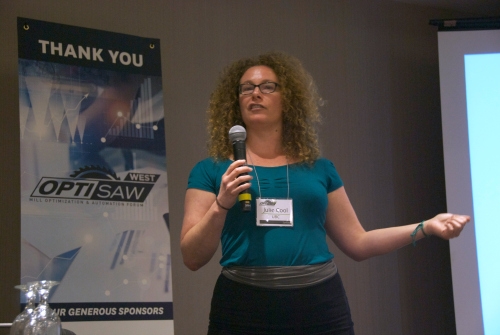
Features
Mills
Sawmilling
OptiSaw West challenges sawmillers with new ideas
April 28, 2017 - From pre-sorting logs beyond small, medium and large to cutting for the mass timber construction market, speakers at OptiSaw West mill automation and optimization forum challenged a crowd of sawmillers to ask themselves: Why not?
April 28, 2017 By Maria Church
 Julie Cool
Julie Cool The OptiSaw forum put on by Canadian Forest Industries drew a select group of more than 30 mill managers, optimization staff and sawmill researchers to the Sheraton hotel in Richmond, B.C., on April 25 for a day of learning about the latest advancements in sawmill technology and processes.
Peter Moonen, national sustainability manager for the Canadian Wood Council, kicked off presentations with a focus on trends in wood construction – including mass timber and passive housing. Moonen stressed the benefits these new wood building projects represent for Canada’s sawmills, but the need for mills to commit new ways of thinking about construction.
“We should be the first and best customers of what’s in our own backyard,” Moonen told the crowd. “We’re leading the way in so many ways.”
Continuing the discussion of mass timber, USNR’s Sam Pope encouraged the audience to consider cross-laminated timber machinery and how it can be installed in current sawmills. USNR’s pneumatic press configuration is modular and can be customized according to product. As more CLT grades are approved in North America, more product sizes will follow, Pope said.
Discussion then moved to sawmill 4.0 with a presentation by Francois Leger, president of software provider PMP Solutions and Jean-Sebastien Pelletier, mill manager of Maibec’s St-Pamphile sawmill in Quebec. Pelletier discussed the lessons learned at St-Pamphile where data is collected to optimize traceability and scheduling. (CFI’s Guillaume Roy toured the mill and wrote about those improvements.) Mill owners need to not only support a 4.0 project but share in the vision and implement change management for operators, Pelletier said.
Doug Strasky presented next on a new method of log split detection developed by USNR. The system uses both geometric and vision scanning to pick up splits and then optimizes the log breakdown. Learn more here.
The Goldeneye 900, a transverse scanner for both green and dry lumber developed by Springer-Microtec and installed for the first time in North America at Teal-Jones Small log mill in Surrey, was the focus of a presentation by Norvin Laudon. The scanner uses an in-house crometic camera designed for imaging wood and is available with X-ray.
Teal-Jones’ general manager of the small log mill, Dan Doyle, piped up from the audience to say the scanner has allowed Teal-Jones to ship out green lumber that is always on grade without going to the planer.
Recently retired vice-president of technical development for Tembec, Bill Love, shared the next presentation spot with Autolog’s Gilles Gauvin to discuss improvements made at Tembec’s Hearst sawmill in Ontario, which involved three projects supplied by Autolog. Vendor financing was key for Tembec, Love said, which created an important supplier-mill relationship. “You’re kind of married, right?” Love told the audience. “It creates a sharper focus on the project and forces trust.”
The Hearst mill upgrades included a canter twin optimizer, gang edger optimizer and a planer autograder, amounting to a $3 million investment with payback in about a year, Love said.
JoeScan president Joey Nelson presented next on strategies to mitigate equipment obsolescence in sawmills. Mills need to ask key questions, Nelson said, such as who controls the equipment design and the internal electronics, how is the equipment supported and is there a warranty, and is the equipment made for sawmills.
Wrapping up the day with something for mill mangers to mull over, Julie Cool, assistant professor of wood science for the University of British Columbia, presented on sawmill solutions in Europe that could be adopted in Canada.
Cool suggested that there are four takeaways from Europe that are likely coming to Canada: X-ray scanning, greater flexibility in production through log sorting, traceability, and advancement in cutting tools.
Cool’s suggestion for mills to consider pre-sorting logs to a greater extent than just small, medium and large ignited some debate among the audience. The goal behind pre-sorting is to increase the speed of primary and secondary machinery. While current technology is impressive enough to handle log variability, Cool suggested pre-sorting would allow for even faster production.
Some audience members challenged the idea that pre-sorting is worth the cost of installing a sorting system, pointing out Canadian dimension lumber mills have access to quality fibre of specific sizes and do not cut for customer specifications.
But with news of the U.S. duties on softwood lumber landing the day before OptiSaw, Cool pointed out that Canadian mills may have to deal with increasing pressure to cut to customer specifications, similar to European mills. “I’m not suggesting we have hundreds of sorting bins, but maybe more than just bins for small, medium and large logs,” Cool said.
Find archived presentations from OptiSaw West 2017 here.
Print this page